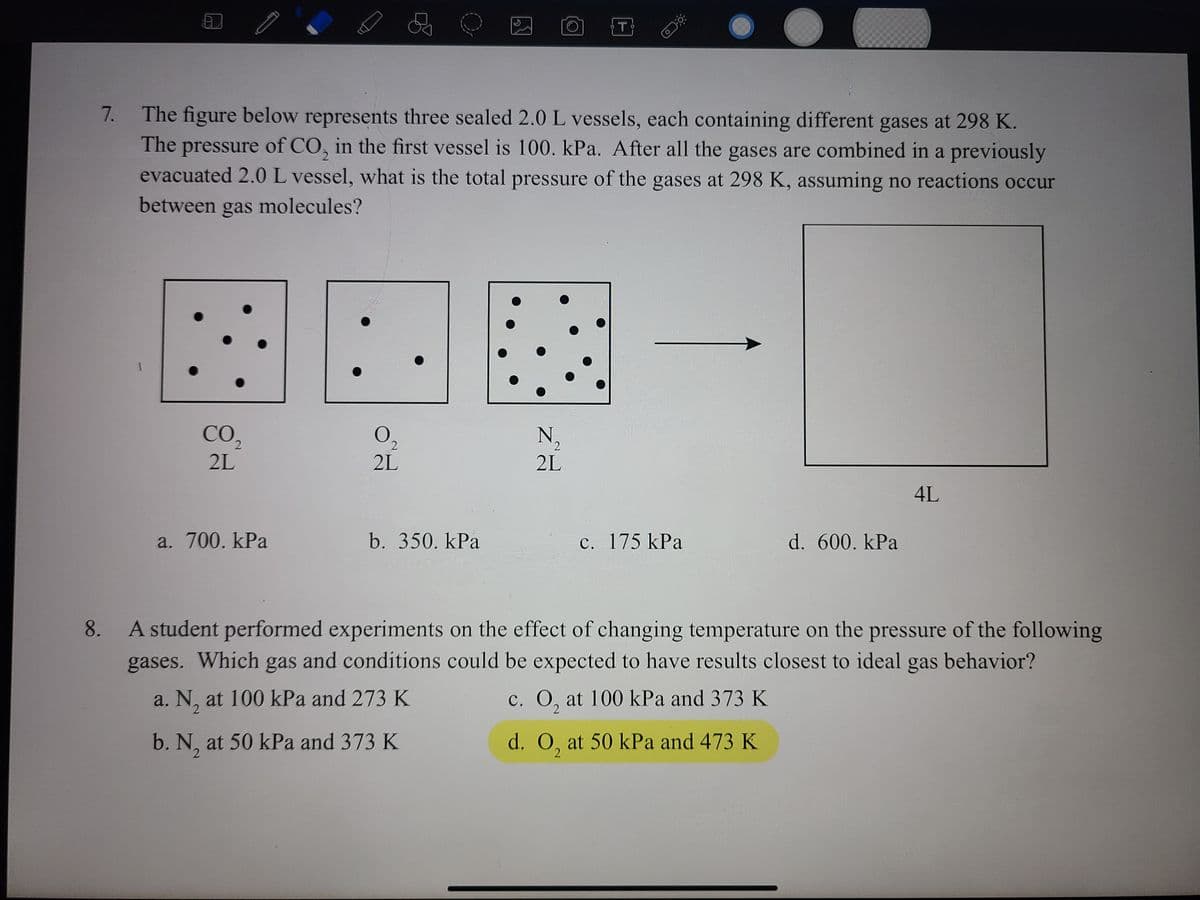7. The figure below represents three sealed 2.0 L vessels, each containing different gases at 298 K. The pressure of CO, in the first vessel is 100. kPa. After all the gases are combined in a previously evacuated 2.0L vessel, what is the total pressure of the gases at 298 K, assuming no reactions occur between gas molecules? 图国圈 CO. 0, 2L N, 2L 2L 4L a. 700. kPa b. 350. kPa с. 175 kPa d. 600. kPa
7. The figure below represents three sealed 2.0 L vessels, each containing different gases at 298 K. The pressure of CO, in the first vessel is 100. kPa. After all the gases are combined in a previously evacuated 2.0L vessel, what is the total pressure of the gases at 298 K, assuming no reactions occur between gas molecules? 图国圈 CO. 0, 2L N, 2L 2L 4L a. 700. kPa b. 350. kPa с. 175 kPa d. 600. kPa
Chemistry
10th Edition
ISBN:9781305957404
Author:Steven S. Zumdahl, Susan A. Zumdahl, Donald J. DeCoste
Publisher:Steven S. Zumdahl, Susan A. Zumdahl, Donald J. DeCoste
Chapter5: Gases
Section: Chapter Questions
Problem 162CP
Related questions
Question
Question 7

Transcribed Image Text:The figure below represents three sealed 2.0L vessels, each containing different gases at 298 K.
The pressure of CO, in the first vessel is 100. kPa. After all the gases are combined in a previously
evacuated 2.0L vessel, what is the total pressure of the gases at 298 K, assuming no reactions occur
7.
2.
between gas molecules?
CO,
N,
2L
2L
2L
4L
a. 700. kPa
b. 350. kPa
c. 175 kPa
d. 600. kPa
A student performed experiments on the effect of changing temperature on the pressure of the following
gases. Which gas and conditions could be expected to have results closest to ideal gas behavior?
8.
a. N, at 100 kPa and 273 K
c. O, at 100 kPa and 373 K
2
b. N, at 50 kPa and 373 K
d. O, at 50 kPa and 473 K
2.
2
Expert Solution
This question has been solved!
Explore an expertly crafted, step-by-step solution for a thorough understanding of key concepts.
This is a popular solution!
Trending now
This is a popular solution!
Step by step
Solved in 5 steps

Knowledge Booster
Learn more about
Need a deep-dive on the concept behind this application? Look no further. Learn more about this topic, chemistry and related others by exploring similar questions and additional content below.Recommended textbooks for you

Chemistry
Chemistry
ISBN:
9781305957404
Author:
Steven S. Zumdahl, Susan A. Zumdahl, Donald J. DeCoste
Publisher:
Cengage Learning

Chemistry: An Atoms First Approach
Chemistry
ISBN:
9781305079243
Author:
Steven S. Zumdahl, Susan A. Zumdahl
Publisher:
Cengage Learning


Chemistry
Chemistry
ISBN:
9781305957404
Author:
Steven S. Zumdahl, Susan A. Zumdahl, Donald J. DeCoste
Publisher:
Cengage Learning

Chemistry: An Atoms First Approach
Chemistry
ISBN:
9781305079243
Author:
Steven S. Zumdahl, Susan A. Zumdahl
Publisher:
Cengage Learning


Physical Chemistry
Chemistry
ISBN:
9781133958437
Author:
Ball, David W. (david Warren), BAER, Tomas
Publisher:
Wadsworth Cengage Learning,

Chemistry: Principles and Reactions
Chemistry
ISBN:
9781305079373
Author:
William L. Masterton, Cecile N. Hurley
Publisher:
Cengage Learning

Chemistry for Engineering Students
Chemistry
ISBN:
9781337398909
Author:
Lawrence S. Brown, Tom Holme
Publisher:
Cengage Learning